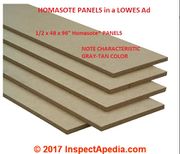Difference between revisions of "Homasote"
m (Text replace - "== Authority ==" to "== Sources Checked for Data in Record ==") |
|||
| (8 intermediate revisions by the same user not shown) | |||
| Line 1: | Line 1: | ||
| + | [[File:Homasote-Panels-Lowes-300-IAPs.jpg|thumb|Credit: InspectApedia.com]] | ||
== Description == | == Description == | ||
| − | [Homasote] A brand name for a series of structural composition boards made from 100% recycled cellulosic material ([[wood]] and recycled newspapers). | + | [Homasote] A brand name for a series of structural composition boards made from 100% recycled cellulosic material ([[wood]] and recycled newspapers). Homasote® boards were originally the boards made with high-density wood fibers, then in 1916 the process was converted to using recycled newspapers mixed with [[wax|waxes]], [[oil|oils]], and other weatherproofing elements. Currently, the cellulose fibers are impregnated with wax, a [[flame retardant]] and a [[biocide]] for protection against [[termite|termites]], rot, and [[fungus|fungi]], then compressed into a high-density board. Homasote® provides structural strength, sound-deadening, weather resistance and temperature insulation. It is available in boards of 1/2" and 5/8" thickness and contains no [[asbestos]] or [[urea formaldehyde resin|urea formaldehyde resins]]. The company makes a wide variety of products used for insulation, sound barriers, wall partitions, tackboards as well as those used for construction of walls, floors, and roofs. |
| + | |||
| + | Text from company website on its production: The recycled paper fiber "slurry is pumped into 8' x 12' forming molds that shape the product by squeezing nearly 25 percent of the water out of it. A squeezed, formed "mat," now 75 percent water and 25 percent pulp, is moved on rollers into giant presses where it is receives from 1,600 to 2,200 lbs-per-square-inch of pressure before it is transported through a 300 ft. enclosed dryer. Prior to drying the board is approximately 25 percent water. At the end of the drying process finished Homasote® board is approximately 5 percent water, 3 percent less water content than plywood. " | ||
== Synonyms and Related Terms == | == Synonyms and Related Terms == | ||
| Line 7: | Line 10: | ||
Homosote (sp) | Homosote (sp) | ||
| − | == | + | ==Risks== |
| + | * Exposure to cellulose dust when cut | ||
| + | * Homasote: [https://www.homasote.com/ SDS sheet list] | ||
| + | * Homasote 440: [www.homasote.com/assets/files/homasote-440-sds.pdf SDS] | ||
| − | Homasote: | + | ==Physical and Chemical Properties== |
| + | for Homasote 440: | ||
| + | * Composition = cellulose (94-98%), wax (1-6%), copper metaborate (<0.1%) | ||
| + | * Color = gray | ||
| + | * Density = 20-30 pcf | ||
| − | == | + | ==Resources and Citations== |
| + | * Homasote: [https://www.homasote.com/ Website] | ||
| + | * Homasote: [https://www.homasote.com/about#:~:text=An%20internationally%20known%20environmental%20icon,the%20U.S.%20Environmental%20Protection%20Agency). History] | ||
| + | * Homasote:[https://www.homasote.com/plant Production] | ||
* ''Dictionary of Building Preservation'', Ward Bucher, ed., John Wiley & Sons, Inc., New York City, 1996 | * ''Dictionary of Building Preservation'', Ward Bucher, ed., John Wiley & Sons, Inc., New York City, 1996 | ||
| − | + | * Pam Hatchfield, ''Pollutants in the Museum Environment'', Archetype Press, London, 2002 | |
| − | * | + | * Thomas C. Jester (ed.), ''Twentieth-Century Building Materials'', McGraw-Hill Companies, Washington DC, 1995 |
| − | |||
| − | * | ||
| − | |||
| − | [[Category:Materials database]] | + | [[Category:Materials database]][[Category:MWG]][[Category: Wood]][[Category: Board/Panel, Composite]] |
Latest revision as of 07:37, 5 April 2025
Description
[Homasote] A brand name for a series of structural composition boards made from 100% recycled cellulosic material (Wood and recycled newspapers). Homasote® boards were originally the boards made with high-density wood fibers, then in 1916 the process was converted to using recycled newspapers mixed with waxes, oils, and other weatherproofing elements. Currently, the cellulose fibers are impregnated with wax, a Flame retardant and a Biocide for protection against termites, rot, and fungi, then compressed into a high-density board. Homasote® provides structural strength, sound-deadening, weather resistance and temperature insulation. It is available in boards of 1/2" and 5/8" thickness and contains no Asbestos or urea formaldehyde resins. The company makes a wide variety of products used for insulation, sound barriers, wall partitions, tackboards as well as those used for construction of walls, floors, and roofs.
Text from company website on its production: The recycled paper fiber "slurry is pumped into 8' x 12' forming molds that shape the product by squeezing nearly 25 percent of the water out of it. A squeezed, formed "mat," now 75 percent water and 25 percent pulp, is moved on rollers into giant presses where it is receives from 1,600 to 2,200 lbs-per-square-inch of pressure before it is transported through a 300 ft. enclosed dryer. Prior to drying the board is approximately 25 percent water. At the end of the drying process finished Homasote® board is approximately 5 percent water, 3 percent less water content than plywood. "
Synonyms and Related Terms
Homosote (sp)
Risks
- Exposure to cellulose dust when cut
- Homasote: SDS sheet list
- Homasote 440: [www.homasote.com/assets/files/homasote-440-sds.pdf SDS]
Physical and Chemical Properties
for Homasote 440:
- Composition = cellulose (94-98%), wax (1-6%), copper metaborate (<0.1%)
- Color = gray
- Density = 20-30 pcf
Resources and Citations
- Homasote: Website
- Homasote: History
- Homasote:Production
- Dictionary of Building Preservation, Ward Bucher, ed., John Wiley & Sons, Inc., New York City, 1996
- Pam Hatchfield, Pollutants in the Museum Environment, Archetype Press, London, 2002
- Thomas C. Jester (ed.), Twentieth-Century Building Materials, McGraw-Hill Companies, Washington DC, 1995
